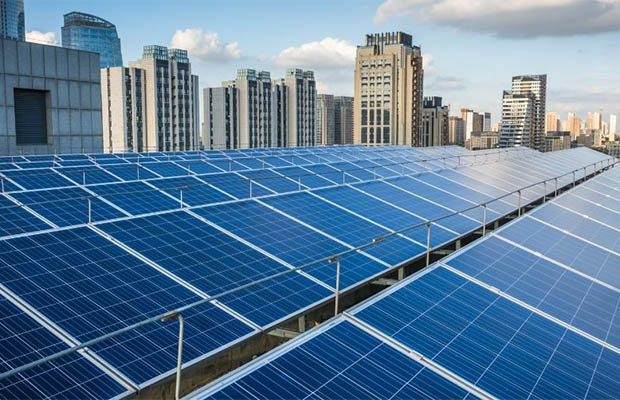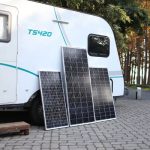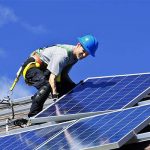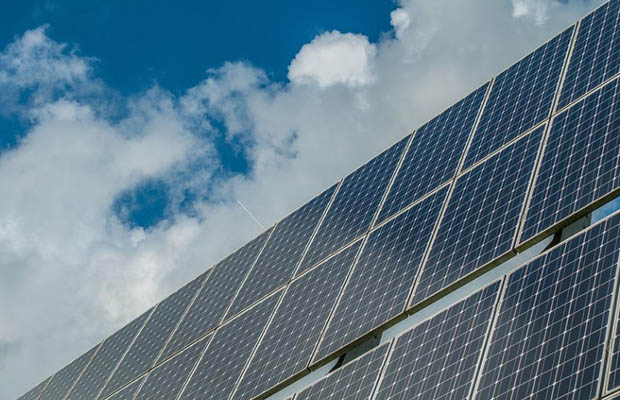Rooftop solar systems are becoming more and more common in U.S. homeowners, commercial solar panel installations can be even more effective at generating low-cost renewable energy. Due to the size at which they can be invested, solar energy has a lot to offer businesses; choosing to add solar to your company is a wise financial decision.
You’ll find a thorough overview of commercial solar panels in this manual. We’ll go over a few reasons why you should think about going solar, the numerous advantages of a powerful solar system, how solar panel efficiency works, and the incentives and rebates offered to businesses like yours that care about the environment.
Related Reading: Commercial And Residential Solar Panels: Main Difference
Table of Contents
- What Does Commercial Solar Panel Installation Look Like?
- Why Use Solar Panels In Businesses?
- How To To Install Commercial Solar Panel?
- Pros Of Commercial Solar Panel
- Cons Of Commercial Solar Panel
- Different Types Of Commercial Solar Systems
- How Efficient Are Commercial Solar Panels?
- What Factors Contribute To Solar Panels’ Efficiency?
- Wha Is The Average Cost Of Commercial Solar Panels?
- FAQs
What Does Commercial Solar Panel Installation Look Like?
Comparatively speaking, commercial solar energy systems come in a much wider range of sizes and applications. Commercial solar arrays typically come in much larger sizes and aren’t always restricted to roofs. While some businesses choose to use ground-mounted solar panels, others choose solar carports.
Larger commercial operations may even feature a “power tower,” an array of mirrors that focus the sun’s rays onto the photovoltaic panels below them. Commercial systems are typically installed on flat surfaces and must be constructed on racks tilted toward the sun at the best angle for the solar panels to harvest the most energy during the day.
Some systems go so far as to have components that synchronize the panel angles (or azimuth) with the sun’s shifting height. For larger commercial installations, a low cost per panel is essential to achieving the quickest return on investment (ROI).
For this reason, we advise choosing the most effective solar panels that are readily available. The installation will be more affordable overall if less space, inventory, and planning are required. Additionally, more effective solar panels have a propensity to last longer, guaranteeing a solid return on investment.
Solar offers commercial property owners an increasing number of options for offsetting a sizable portion, or even the entire, of a business’s electricity bill. The cost of a commercial solar system is high, but solar incentives, tax breaks, and new technologies make it an extremely appealing investment.
Why Use Solar Panels In Businesses?
Solar energy is not a trend; rather, it is a dependable, sustainable resource that provides excellent ROI, scalability, and cost-effectiveness.
In particular, there are three main benefits to why you should go solar with your business:
1. Cutting Your Energy Costs And Saving Money On Utility Bills
Commercial solar panels typically pay for themselves within three to five years of installation. After that, your energy is completely free. Each kWh of solar energy generated by your system means that you no longer need to purchase energy from the grid, saving you money on your monthly utility bill.
Governments and utilities are providing ever-increasing incentives and rebates for companies that go solar as if that weren’t already commendable enough. In contrast to giving your money to a utility company, you could save thousands of dollars on the cost of your system setup. With that extra cash, you could use it to expand your business.
2. Reducing Your Company’s Carbon Footprint
Solar energy systems assist companies in transitioning to a more sustainable future by lowering greenhouse gas emissions. 31,500 metric tons of CO2 emissions are offset by each MW of solar energy produced.
In the past, businesses have been the biggest net producers of greenhouse gases. But things are changing. The US, for instance, now has nearly 114 GW of installed solar power capacity, which is sufficient to offset more than 127 million metric tons of CO2 emissions. Additionally, the number is rising.
By switching to solar power, you can assist your company in lessening its environmental impact and taking the lead in the global fight against climate change.
3. Attracting Environmentally Conscious Customers
34% of consumers said they would be willing to pay more for sustainable products in the 2021 Global Sustainability Study.
A great way to demonstrate to your clients your dedication to sustainability and carbon footprint reduction is by offering solar installation. Additionally, as the zero-waste movement gains momentum, customers will increasingly favor shopping at companies that share their values (like yours).
For businesses of all sizes, going solar is advantageous. In addition to lowering your energy costs, it benefits the environment and may draw in more customers.
Are you prepared to change? Find a distributor today and let Hoymiles provide you with the ideal solar solution.
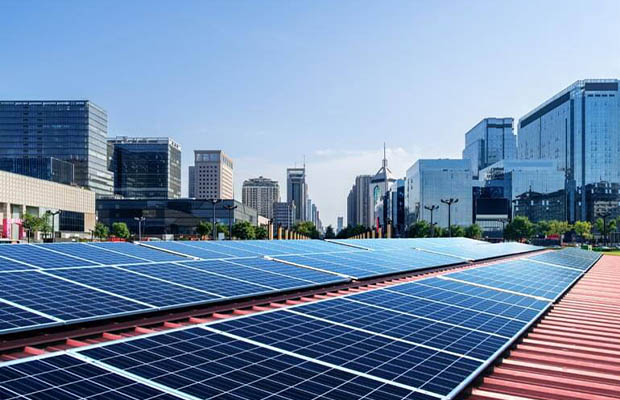
How To To Install Commercial Solar Panel?
- 1. Plan a Site Audit A review of your utility bills will be done by the solar company during the audit to assess utility costs and consumption. They will finish a thorough inspection of the structure or surrounding area. To help with system design, information about the facility is gathered, including measurements of beams and structural walls. The installer follows up by submitting a proposal that includes the system’s suggested size, slope, orientation, and location. A description of the wiring is included, along with information on the precise models of the solar panels and inverters. The proposal will include projected energy costs and savings, warranty information, and the cost of the system, including labor and equipment, fewer rebates, and other incentives.
- 2. Review the Engineer’s Plan Solar engineers plan, design, and occasionally implement the solar energy project using the data they receive from the audit. The engineer might provide updates on the project’s cost, effectiveness, and safety throughout this process. The engineer might participate in the site audit depending on the solar company.
- 3. Complete Permitting All permitting requirements must be satisfied after the system’s plans are finished. Unfortunately, there is no set procedure for obtaining permits. This process can proceed quickly or take a lot of time and money, depending on the state, and local government, size, and complexity of the system. One of the employees at Shadzi’s Cosmic Solar is responsible only for obtaining permits. At this point, the owner of the system or their installer will start filling out paperwork for incentives and rebates.
- 4. Watch Your Panels Get Installed Each project is unique and depending on the size of the system, it may take anywhere from two days to two weeks or longer. In order to install solar panel mounts for the typical attached or hybrid system, holes must be drilled into the rafters. Then, to stop water leakage, thin metal pieces are put over the mounts. The panels are connected by being fastened to the rails. The solar panels are then connected to the inverter.
- 5. Schedule Final Inspection The utility or city building department will carry out a final inspection prior to it being put to use. Inspectors make sure that the additions to the building or grounds adhere to building codes and that the appropriate permits have been obtained.
- 6. Submit Utility Interconnection Request Owners of systems submit a request for interconnection to their utility. The waiting period for interconnection, prerequisites, costs and application formats will change depending on where you live. Each state is in charge of interconnection to the grid, which can be a very complicated and expensive process in many parts of the nation.
- 7. Activate Monitoring Plan The typical grid-tied solar system requires very little maintenance because it has no moving parts. Maintain a clean system free of dust and debris, and clean with mild soap and a mop or squeegee to get rid of tough dust or bird droppings. A system owner can also get useful information about a system’s performance from monitoring devices and services, such as how much money and CO2 have been saved.
Related Reading: How Long Does It Take To Install Solar Panels?
Pros Of Commercial Solar Panel
Businesses gain significant advantages over time, despite the fact that the initial investment in a solar installation can be expensive. Some of the top benefits of solar panels for businesses include:
Increased Property Value
Commercial property can become more appealing to buyers by adding significant value with solar installations. According to studies, solar-paneled properties can sell up to 20% more quickly and for 15% more money than those without them.
Tax Breaks
Businesses can also benefit from a number of tax breaks and incentives for installing solar panels. For instance, the federal government of the United States offered a 30% tax credit for commercial solar installations in 2019. Although that percentage has dropped to 26%, it is still high enough for any company to benefit greatly from.
Improved Energy Independence
Businesses can increase their energy independence with solar panels, which is crucial for those who depend on the centralized grid. Businesses can even completely disconnect from the grid when a solar system is used in conjunction with a reliable battery storage system.
Marketing Benefits
Additionally, solar installations offer businesses a significant marketing opportunity. Businesses can demonstrate their concern for the environment and dedication to sustainability by going solar. This may be a significant selling point for clients who care about the environment and may help draw in new clients.
Environmental Benefits
Naturally, installing solar also has a number of advantages for the environment. It lowers greenhouse gas emissions, aids in energy resource conservation, and lessens the use of dangerous fossil fuels.
Reduced Electricity Bills
You’ll begin using the sun’s energy to produce your own power once your solar system is operational. Your monthly utility bill may be significantly reduced as a result of not having to purchase electricity from the grid.
Increased Resiliency
Businesses that have solar installations are more resilient to power outages and grid failures. Solar-powered businesses can still generate electricity for their operations even if the grid goes down.
Cons Of Commercial Solar Panel
May Need To Upgrade Roof/Electrical System
Following the site audit, it might become clear that the electrical or roofing systems need to be upgraded or even replaced. For business owners looking to cut costs, solar energy may not be as appealing due to its high upfront cost.
Upfront Costs
The business owner might have to pay a lot upfront for the solar energy system installation depending on the financing method. A system can be very expensive to buy outright. There are other options, though, that cost little to nothing upfront.
Weather Unpredictability
More sunlight leads to increased electricity production. Even business owners who reside in regions with erratic or cloudy weather can gain from solar. To generate the same amount of energy as someone living in a state with plenty of sunshine, they might merely need to use more panels.
Unpredictability Of Puc Decisions
Legislative restrictions on net metering are slowing the growth of solar energy installations in a number of states across the country. The public utility power grid can be connected to a solar system thanks to net metering, which also makes solar economically feasible. The customer can reduce the cost of power drawn from the utility by transferring surplus power onto the grid.
Different Types Of Commercial Solar Systems
Over the past 60 years, solar technology has advanced quickly, and today’s solar installation and design companies can work with almost any type of property to start reducing costs with solar electricity.
Carports
Business owners can effectively utilize large parking areas thanks to solar carport systems. These systems are able to generate electricity while additionally offering shade and covered parking. Carports are an easy and affordable way for business owners who cannot install roof-mounted systems to generate solar power. Those who want to boost the energy output of their current rooftop solar systems can do so with them in a stylish way. In addition to providing simple access for cleaning and maintenance, panels on carport structures.
Flat rooftop systems
For flat rooftop systems, there are three primary options available to business owners: attached, ballasted, or a combination of the two. The roof, the building’s construction process, and a structural engineering analysis will all influence which system is selected. An attached system depends on connections to the framing and holes drilled into the roof’s surface. Instead of using ballast, a ballasted system uses the weight of the system, which includes the panels, racking, and other materials, to hold the array down. A hybrid system, which requires both penetrations and ballasting, is regarded as a minimally attached system.
Ground systems
For businesses with rooftops that are not suitable for solar or that are too small to meet electricity needs, ground-mounted systems are a cost-effective alternative. Ground-mounted systems can be sized to match electricity consumption and created to be as efficient and productive as possible if the business owner has the land available. There are two primary categories of ground mounts. To maintain solar panels at a fixed angle, standard ground mounts use metal framing that is driven into the ground. Pole mounts raise panels higher off the ground and sometimes tilt them toward the sun using tracking systems.
Tracker systems
As the panels move to follow the sun, trackers are made to produce more energy. Dual-axis systems track along both the x and y axes, while single-axis systems move the panels from east to west. Ideally, tracking systems enable customers to receive more kilowatt-hours per panel. In contrast to the typical solar system, which is mounted at a fixed angle and has no moving parts, they cost more to develop and install and maintain. Although trackers are not as widely used as conventional fixed-mounted systems and their dependability is frequently questioned, technological advancements may soon make them more popular and reliable.
Slanted rooftop systems
With the development of solar technology, slanted roofs of all shapes and sizes can now be supported. Even if the roof is sloped and made of metal, composition shingles, wood shingles, or even Spanish tile, commercial solar suppliers and installers can work with business owners to take advantage of solar power and its many advantages. Ballasted mounting systems cannot be used for slanted rooftops, which need to be anchored to the roof with penetrations.
Artistic systems
Business owners who want to make a bold statement should think about artistic systems. Now, solar panels can be arranged into artistic, lovely arrays that communicate a message without compromising energy output. One company in North Carolina, CEI, put in a solar array on their rooftop with the panels arranged to spell out the name of the business. Currently, CEI can be seen on satellite pictures taken from space. Thanks to the playful and recognizable shape of the Mickey Mouse, Disney’s solar farm in Florida boasts powerful brand messaging. While these are examples of large arrays, smaller systems can also be created for precise branding. However, as is to be expected, the cost of design or installation will probably increase the more specialized and distinctive a system is.
Utility-scale systems
Clean energy produced by utility-scale solar is sold to utilities, not to individual consumers. These clean energy projects are encouraged to be developed by federal and state policies. The Solar Energy Industries Association claims that in the U.S. there are currently 37,000 utility-scale solar projects, and another 74,000 MW are currently being developed. Utility-scale solar has many advantages, such as positive effects on the environment and financial advantages. One of the quickest ways to cut carbon emissions is through solar power on such a large scale. Furthermore, compared to fossil fuels, which are constantly fluctuating in price, these solar power plants produce electricity at a fixed price.
How Efficient Are Commercial Solar Panels?
The efficiency of solar panel technology has advanced significantly in a short period of time. An average solar panel’s efficiency was around 14% in 2010. There is still plenty of room for growth even though that percentage has increased to somewhere between 15% and 20% today.
What does this mean? A 13% efficiency panel can generate 130 watts of energy from 1,000 watts of sunlight. In contrast, a panel with a 20% efficiency can generate 260 watts of power. Solar panels will become a more appealing investment for companies of all sizes as efficiencies rise and returns on solar energy decline in relation to their initial cost.
What Factors Contribute To Solar Panels’ Efficiency?
The materials used in solar panels, their design and construction, and the local climate all have an impact on how efficient they are.
Reflectivity
Reflectivity is a crucial element. A well-designed panel will have a glass with a low coefficient of reflection, which means that the majority of sunlight that strikes it will be absorbed and turned into electricity. High-reflectivity panels will let some of the sun’s energy bounce off their surface.
Material Type
The type of material used in the solar cell is possibly the most crucial aspect of efficiency. Today, monocrystalline or polycrystalline silicon is used to make the majority of commercial solar panels. Monocrystalline solar panels are typically more efficient than their polycrystalline counterparts because they are made of a single, large silicon crystal. Therefore, monocrystalline solar panels make up the majority of contemporary, high-efficiency commercial solar panels.
Operating Temperature
Between 59°F and 95°F is typically a suitable operating temperature range for solar panels. Most panels are tested at a temperature of 77°F, but efficiency dramatically decreases when temperatures start to rise or fall outside of that range.
Though many consumers believe otherwise, hot climates like Texas or Arizona are ideal for solar energy not because of their hot weather, but because of their long, sunlit days – their warmer temperatures actually hamper the energy production of solar panels in these regions because of high temperatures cause silicon to produce more heat than electricity.
Efficiency Is Ever-growing
Solar panel efficiency is still expected to increase significantly, according to scientists, and there are no signs that this technology will slow down anytime soon.
Case in point? Newer solar panel technologies like PERC (passivated emitter and rear contact) and HIT (heterojunction with intrinsic thin layer), are even more efficient than solar panels made just a few years ago, often reaching efficiencies as high as 25% or more.
However, it’s important to keep in mind that these more recent products are frequently more expensive, and since some of them are still in the experimental stage, it’s unclear how reliable they will be in the long run.
Wha Is The Average Cost Of Commercial Solar Panels?
Depending on the size of the system you need and your business’s energy needs, the average cost of commercial solar panels varies.
Commercial rooftop photovoltaic systems typically cost less than US$2 per watt, according to a recent study by the National Renewable Energy Laboratory (NREL). As solar technology advances, this price will likely continue to decline from almost $4 per watt in 2008.
Similar price reductions have also affected smaller residential systems, which now cost between $2.50 and $3 per watt (for those between 10 and 100 kW). Therefore, even though solar energy is becoming more affordable overall, economies of scale still hold true; larger commercial systems are typically more cost-effective than smaller residential ones.
This means that the higher your company’s energy requirements, the higher your absolute upfront costs will be. Additionally, your system’s cost per watt will be lower, making solar an even more financially wise investment.
Average Cost Of Installation
The price of labor accounts for a sizeable portion of the cost of commercial solar panels. Around US$0.30 per watt, or 10%–20% of the cost, is typically spent on labor for solar installation. Therefore, installing a 100 kW system would cost around US$30,000; however, the price will vary based on your location and the company you choose to handle the installation.
A reminder: these fees are the gross cost. Rebates and grants for solar panel installation can frequently significantly lower the cost for your company.
Maintenance Costs
The ongoing maintenance costs should also be taken into account. Although solar panels typically require very little maintenance, there will undoubtedly be some costs for routine upkeep and the occasional repair.
For instance, if bird droppings are frequently left on your panels, this may result in significant staining and decreased effectiveness. Similarly, you should repair any scratched or damaged panels as soon as you can to reduce energy loss.
Annual or semi-annual maintenance is usually sufficient.
Other Costs
Finally, there are a few additional incidental expenses you might want to take into account. If your company’s property is located in an area that is regulated, for instance, you might have to pay for a permit. To handle the surge of solar energy, you might also need to upgrade your electrical infrastructure.
You can estimate these costs and take grants, rebates, and subsidies into account with the aid of an expert solar panel installation company. See how Hoymiles can assist by getting in touch right away!
FAQs
Are Commercial Solar Panel Installations Worthwhile?
One of the best financial investments a company can make is the installation of solar panels. Businesses can offset significant portions of their energy costs while promoting an ethical reputation if they have the right space and climate for solar panels. There has never been a better time for businesses to invest in solar energy thanks to a number of soon-to-expire commercial incentives.
When Will Commercial Solar Panels Be Installed?
Commercial solar installations can require a more involved installation procedure because they are typically much larger than residential installations. Commercial solar panel installations can take weeks or months to complete, depending on the system’s size. Connecting with a nearby local solar installer is the best way to find out how long an installation would take for your company.
Can Commercial And Industrial Uses Of Solar Panels Be Made?
Yes, commercial and industrial solar installations sometimes provide benefits that surpass those of residential solar panels. Due to the size of most commercial installations, price-per-watt is lower, giving customers a lot more value for their money. Commercial installations are still eligible for solar tax credits, net metering, and some tax deductions, making them a wise investment for business owners.
How Many Solar Panels Will I Need To Install In A Commercial Setting?
The number of solar panels required for an installation will primarily depend on the installation’s objectives and the amount of panel space that is available. Although some commercial solar operations, such as solar farms, generate and sell energy for a profit, the majority of businesses only seek to offset their own energy costs. They will only need to purchase the number of panels required to meet their energy needs, not as many as they can fit. Contacting a local solar installer for a free proposal is the best way to figure out precisely how many panels your home will need to meet its energy requirements.

